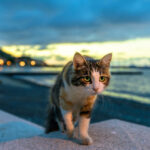Tortoiseshell Cats, affectionately known as “torties,” are more than just a pretty coat pattern. They are renowned for their distinctive mottled fur, unique genetic makeup, and spirited personalities often dubbed “tortitude.” This article delves into the fascinating world of tortoiseshell cats, exploring everything from their striking colors to the folklore surrounding them, and what truly makes these felines stand out.
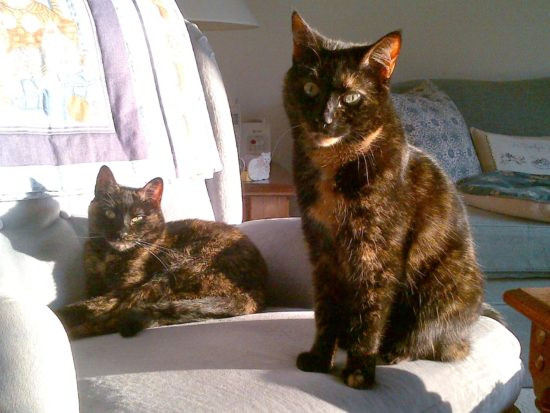 Two tortoiseshell cats sitting side-by-side, one with more orange and the other with more black fur.
Two tortoiseshell cats sitting side-by-side, one with more orange and the other with more black fur.
What Exactly is a Tortoiseshell Cat?
Despite common misconceptions, tortoiseshell is not a breed of cat. Instead, it refers to a striking coat color pattern characterized by a mix of two colors other than white. These colors typically include patches of black, brown, red, amber, cinnamon, and chocolate. The distribution of these patches varies dramatically, ranging from fine speckles to bold, distinct blotches.
Tortoiseshell cats are often confused with calico cats, but there’s a key difference. Calicos are also tri-colored, but they possess significant white patches in addition to the tortoiseshell colors. In contrast, true tortoiseshell cats have little to no white fur.
Variations within tortoiseshell patterns are also common:
- Dilute Tortoiseshell: These cats exhibit softer, muted versions of the classic tortoiseshell colors. Black appears as grey, and orange becomes cream, creating a pastel-like effect.
- Chocolate Tortoiseshell: Characterized by a predominantly dark coat with rich black and chocolate tones, these torties are often particularly striking.
- Torbies: When the tortoiseshell pattern combines with tabby stripes, the result is a “torbie.” These cats display the mottled tortoiseshell coloration alongside the distinctive stripes of a tabby cat.
It’s crucial to remember that the tortoiseshell pattern can appear in various cat breeds, from domestic shorthairs to Persians, highlighting that it’s a color variation, not a breed in itself.
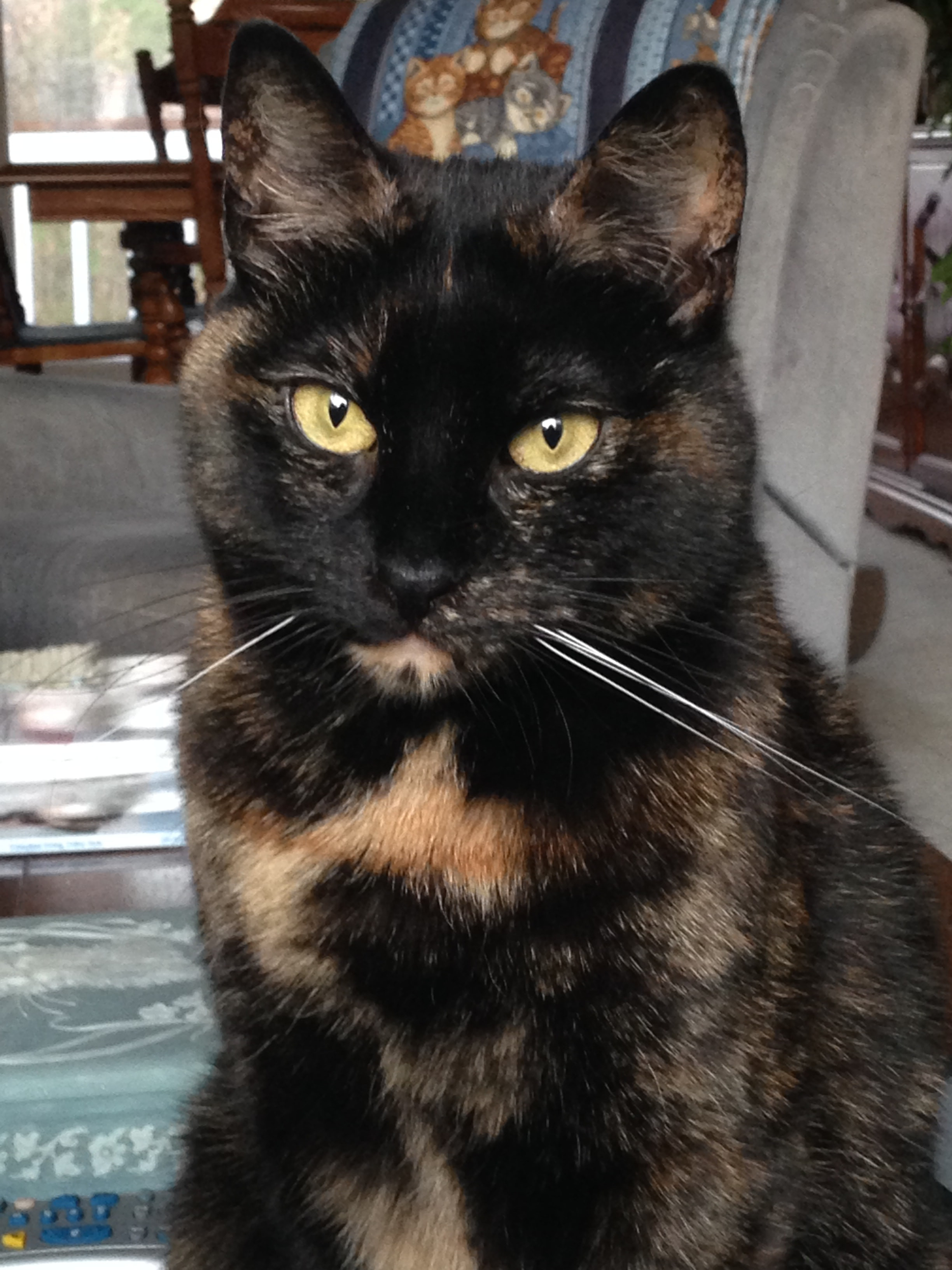 A close-up shot of a tortoiseshell cat's face, showcasing the distinct patches of orange and black fur.
A close-up shot of a tortoiseshell cat's face, showcasing the distinct patches of orange and black fur.
The Intriguing Genetics Behind the Tortoiseshell Coat
The captivating tortoiseshell coloring is a result of unique genetics linked to the X chromosome. A cat’s base coat color is determined by a primary gene, but the tortoiseshell pattern arises from two co-dominant genes present on the X chromosome. These genes work together to express both black and orange pigments simultaneously in the fur, creating the characteristic brindled or patched appearance. Dilute colors occur when a modifying recessive gene softens these primary colors.
One of the most fascinating aspects of tortoiseshell genetics is its strong link to sex. The genes responsible for orange and black coloration are located on the X chromosome. Females, possessing two X chromosomes (XX), can therefore inherit and express both colors, leading to the tortoiseshell pattern.
Males, on the other hand, typically have one X and one Y chromosome (XY). This genetic makeup makes it statistically rare for a male cat to be a tortoiseshell. A male tortoiseshell cat is usually the result of a genetic anomaly where the cat inherits an extra X chromosome (XXY). This condition, similar to Klinefelter syndrome in humans, occurs in only about 1 in 3,000 male cats.
Furthermore, a separate gene governs the tabby pattern. When this gene is present in a tortoiseshell cat, it creates a “torbie,” blending the mottled colors with tabby stripes. Like all tortoiseshell cats, torbies are also predominantly female due to the X-linked genetics of the tortoiseshell pattern.
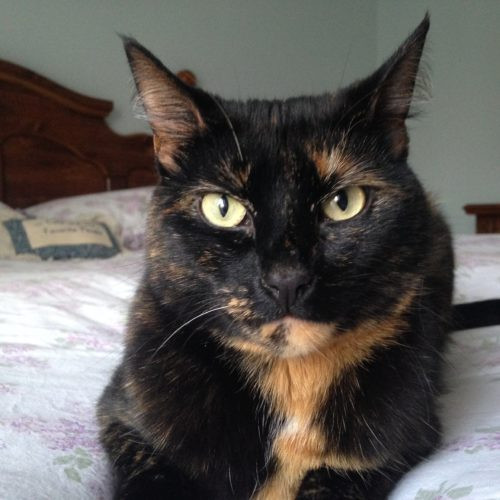 A tortoiseshell cat with a tabby pattern visible in its fur, demonstrating the "torbie" variation.
A tortoiseshell cat with a tabby pattern visible in its fur, demonstrating the "torbie" variation.
Tortoiseshell Cats in Folklore and Culture
Beyond their visual appeal, tortoiseshell cats are steeped in folklore and mythology across various cultures, often associated with good fortune and unique powers. The rarity of male tortoiseshell cats further contributes to their mystique in many traditions.
- Celtic Traditions: In Celtic cultures, a male tortoiseshell cat entering a home was considered a harbinger of good luck and prosperity.
- English Folk Beliefs: English folklore suggests that rubbing a wart with the tail of a male tortoiseshell cat during May could cure it.
- Japanese Fishermen’s Lore: Japanese fishermen believed that male tortoiseshell cats could protect their ships from storms and malevolent spirits, making them prized ship cats.
- Khmer Legend: A Khmer legend from Southeast Asia recounts that the first tortoiseshell cat originated from the blood of a goddess born from a lotus flower, imbuing them with divine origins.
Across cultures, tortoiseshell cats are often seen as symbols of good luck and even referred to as “money cats,” believed to attract wealth and fortune to their owners. Additionally, some traditions associate them with psychic abilities and the power to foresee the future, with dreams of tortoiseshell cats foretelling good luck in love.
“Tortitude”: Is the Tortoiseshell Cat Personality Real?
Perhaps the most talked-about trait of tortoiseshell cats is their distinct personality, often summarized by the term “tortitude.” This colloquialism describes a set of personality characteristics commonly attributed to torties, including being strong-willed, fiercely independent, and sometimes a bit hot-tempered or unpredictable. They are often described as vocal cats who are not shy about expressing their needs and opinions, ranging from gentle meows to assertive hisses.
Anecdotal evidence from tortie owners frequently supports the concept of tortitude. Many report their tortoiseshell cats as being particularly demanding of attention, possessive of their humans, and displaying a wide range of emotions, sometimes shifting quickly from affectionate to aloof.
However, it’s essential to approach “tortitude” with a balanced perspective. While many tortoiseshell cats may exhibit these traits, personality is a complex mix of genetics and environmental factors. Not every tortie will perfectly fit the “tortitude” stereotype, and individual personalities will vary greatly.
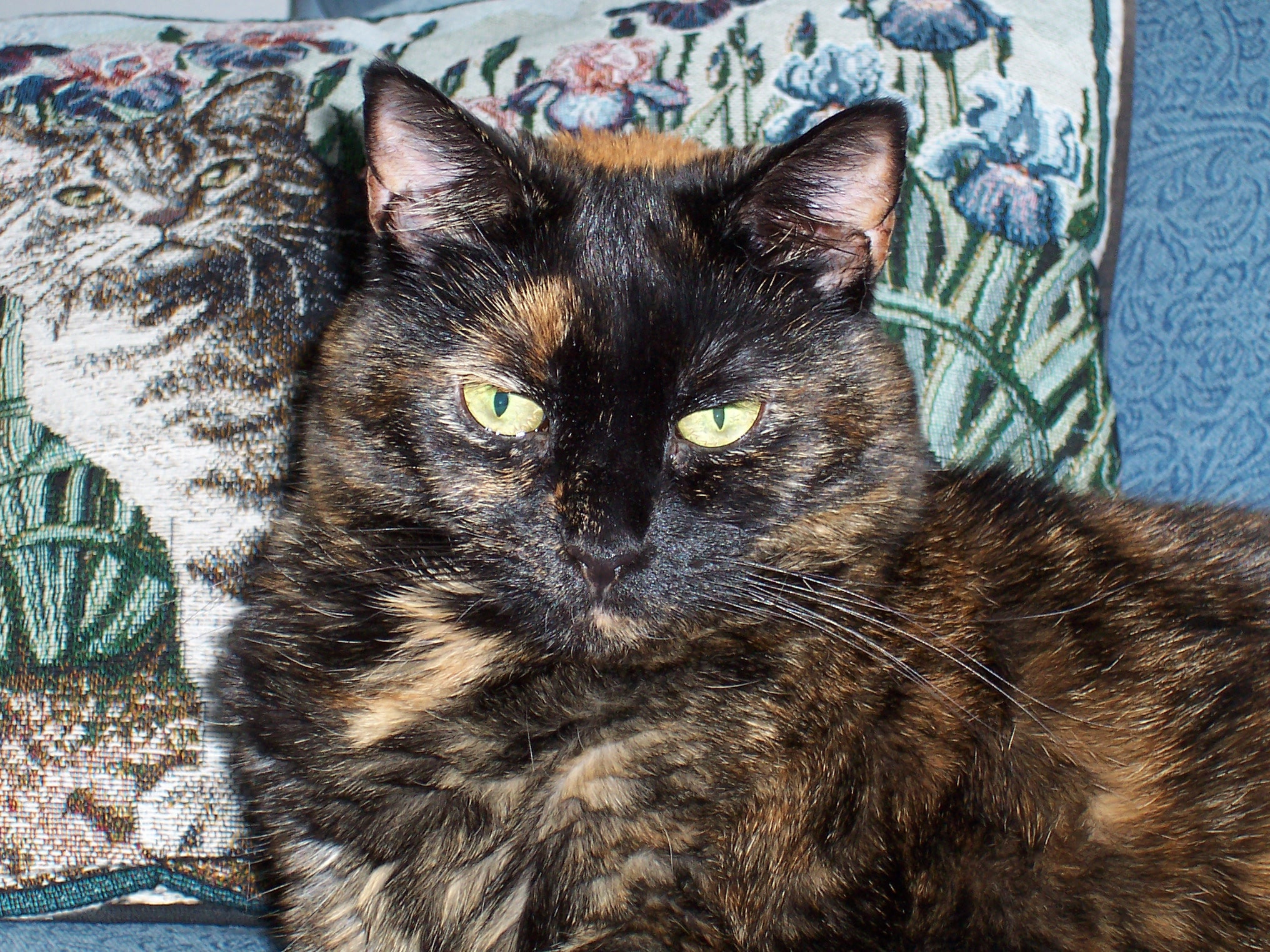 A tortoiseshell cat with a tabby pattern visible in its fur, demonstrating the "torbie" variation.
A tortoiseshell cat with a tabby pattern visible in its fur, demonstrating the "torbie" variation.
Expert Opinions on Tortoiseshell Cat Temperament
Veterinary professionals and cat behaviorists offer varied perspectives on the idea of “tortitude.”
Dr. Fern Slack, a feline veterinarian, playfully compares torties to “redheads of the cat world,” noting their beauty but also suggesting a tendency towards being short-tempered. However, she also acknowledges the immense love and affection they offer, implying that “tortitude” might be a small price to pay for their devoted companionship.
Dr. Elizabeth Colleran, a former president of the American Association of Feline Practitioners, takes a more scientific stance. She states that there’s no definitive scientific evidence linking coat color genes directly to personality traits. She suggests that the perception of “tortitude” might be partly due to the fact that most tortoiseshell cats are female, and female cats are sometimes stereotyped as being more assertive. She emphasizes that personality is ultimately shaped by a combination of genetics and environment.
Jackson Galaxy, a renowned cat behaviorist, acknowledges the reality of “tortitude” based on his extensive experience. He believes that torties and calicos are particularly sensitive to energy, which may contribute to their seemingly strong personalities and expressive behaviors. He views them as highly attuned to their surroundings and therefore having “more to say.”
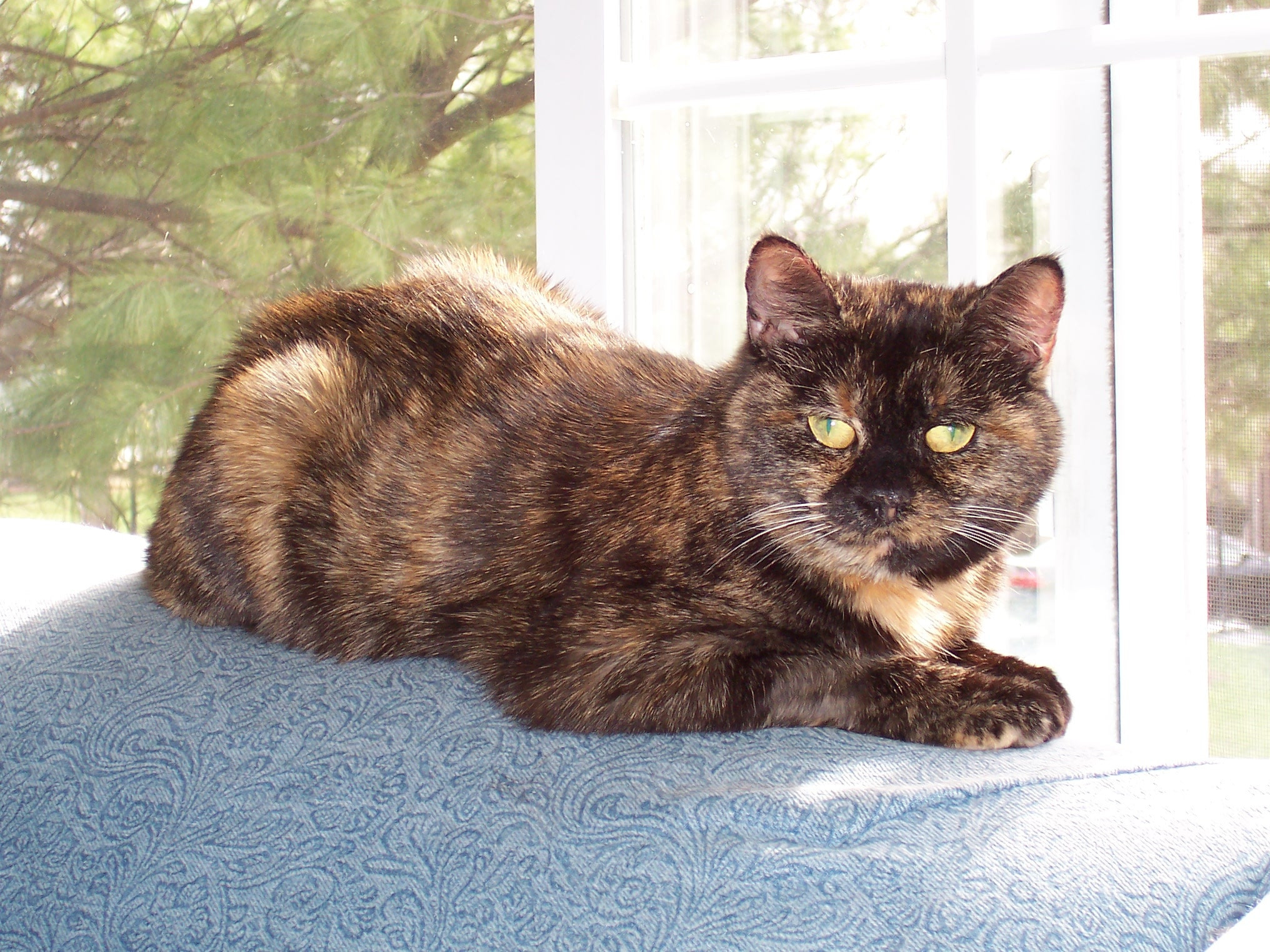 A tortoiseshell cat lounging comfortably on a loveseat, looking relaxed and content.
A tortoiseshell cat lounging comfortably on a loveseat, looking relaxed and content.
Embracing the Tortoiseshell Cat
Whether “tortitude” is a scientifically proven phenomenon or a charming myth, there’s no denying the unique appeal of tortoiseshell cats. Their striking coat colors, fascinating genetics, and spirited personalities make them truly special companions. While not every tortie will embody every trait associated with “tortitude,” many owners find that these cats are intelligent, engaging, and deeply affectionate, offering a rewarding and dynamic feline friendship. For those who appreciate a cat with a bit of spice and a lot of love to give, a tortoiseshell cat might be the perfect match.

